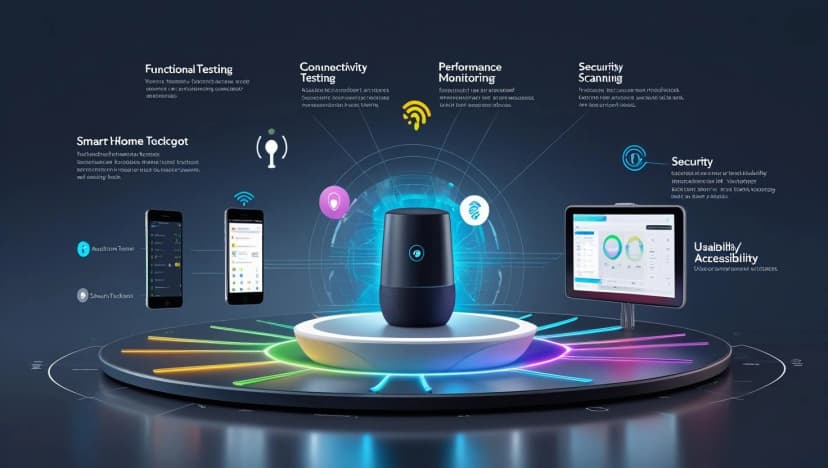Smart Device Testing Services: Complete Guide
Smart devices have transformed the way we live, work, and connect — from wearables tracking our health to smart home ecosystems automating daily tasks. But the success of any smart device depends on reliability, performance, security, and seamless user experience. Even a minor flaw in connectivity, battery life, or cloud integration can cause customer dissatisfaction and brand damage.
This complete guide to Smart Device Testing Services will walk you through the critical aspects of quality assurance for IoT-enabled devices, the challenges in testing, proven methodologies, and the key metrics to ensure your smart device ecosystem operates flawlessly.
Understanding Smart Device Testing
Smart device testing refers to the process of validating the functionality, performance, connectivity, security, and interoperability of internet-connected devices such as wearables, home automation systems, smart appliances, and industrial IoT hardware.
Unlike traditional software, smart devices involve both hardware and software components interacting in real time. This means QA must extend beyond app or firmware validation to cover sensor accuracy, wireless protocol compliance, and device-to-device communication.
Why Smart Device Testing Is Crucial
With billions of connected devices in use worldwide, customers expect instant response, long battery life, secure communication, and seamless integration. A single performance issue or security flaw can lead to recalls, regulatory penalties, and reputational loss.
Inadequate testing can cause:
Device connection drops during use
Inaccurate sensor data leading to poor user experience
Excessive battery drain from unoptimized firmware
Security breaches through unencrypted communication
Cloud sync failures resulting in data loss
These risks make end-to-end smart device testing a non-negotiable step before market launch.
Core Areas of Smart Device Testing
We break smart device testing into specialized service areas, each addressing a specific risk or performance factor.
- Connectivity Testing
Smart devices rely on protocols like WiFi, Bluetooth, Zigbee, Z-Wave, NFC, and LTE to function. Connectivity testing ensures stable pairing, minimal dropouts, and interoperability across routers, hubs, and mobile platforms. - Battery & Power Testing
Battery life is a top consumer concern. We simulate real-world usage patterns to measure battery drain, charging speed, and thermal behavior under stress conditions. - User Experience (UX) Testing
From interface design to accessibility compliance, UX testing validates that users can operate devices easily — regardless of age, ability, or technical skill. - Cloud Integration Testing
Smart devices often store and process data via AWS IoT, Azure IoT Hub, or Google Cloud IoT. Cloud integration testing ensures secure and reliable sync, remote management, and OTA updates. - Security Testing
We conduct penetration tests, encryption validation, and authentication checks to prevent unauthorized access, data leaks, and device hijacking. - Performance Testing
Performance validation checks device load handling, latency, responsiveness, and multi-device interaction in real-world conditions. - Compliance & Certification Testing
Ensures devices meet global standards like CE, FCC, ISO 27001, and industry-specific regulations for healthcare, industrial IoT, or consumer electronics.
Smart Device Testing Process
| Phase | Activities | Outcome |
|---|---|---|
| Requirement Analysis | Device specs review, protocols, compliance goals | Custom test plan |
| Test Environment Setup | Lab setup, simulators, cloud integration | Ready test bed |
| Functional & Connectivity | Protocol, pairing, and feature validation | Feature compliance |
| Performance & UX | Load tests, battery simulation, UI/UX checks | Optimized user experience |
| Security & Compliance | Penetration tests, encryption, audit | Risk-free deployment |
| Reporting & Certification | Reports, defect logs, hand-over certifications | Market readiness |
Challenges in Smart Device Testing
Testing devices is complex due to:
- Multiple protocols: WiFi, BLE, Zigbee, NFC, each with unique quirkstestriq
- Real-time performance requirements: Critical for smart locks, alarms, health trackerstestriq
- Diverse hardware across versions/brandstestriq
- Security threats: Weak firmware, default credentials exploitedtestriq
- Interoperability: Ensuring smooth integration with other ecosystem componentstestriq
- Data volume management and infrastructure bottleneckstestriq
To address these, testers use real device labs, network emulators, and automated frameworks.
Key Metrics for Measuring Smart Device Quality
- Connectivity success rate (%)
- Average latency (ms)
- Battery drain rate (%)
- Cloud sync success rate (%)
- Data packet loss (%)
- Security vulnerabilities found
- Compliance audit score
These KPIs quantify device readiness and provide actionable insights for improvement.
Frequently Asked Questions (FAQs)
Q1: How is smart device testing different from regular software testing?
Smart device testing validates both hardware and software, emphasizing connectivity, sensor accuracy, and real-world environments.testingmind
Q2: Can testing be done before manufacturing is complete?
Yes—digital twins, prototypes, and simulators allow pre-production testing.frugaltesting
Q3: How often should smart devices be tested after launch?
Testing should occur during every firmware update cycle and integration, as well as after applying significant patches.
Conclusion: Delivering Smarter, Safer Devices
Smart devices are at the core of modern living, but their complexity demands rigorous, multi-layered QA. From connectivity to compliance, every aspect must be validated to ensure a product that delights users and protects brand reputation.
At Testriq, we offer end-to-end smart device testing services — helping you launch products that are reliable, secure, and future-proof.
Get Your Smart Device Certified for Success
Real device & lab-based testing
Multi-protocol validation (WiFi, BLE, Zigbee, NFC, LTE)
Security audits & certification support
Cloud & OTA update testing
About Nandini Yadav
Expert in Automation Testing Services with years of experience in software testing and quality assurance.
Found this article helpful?
Share it with your team!
